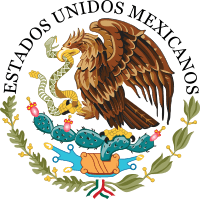Francisco León de la Barra
| Francisco León de la Barra | |
|---|---|
 | |
32nd President of Mexico | |
|
In office May 25, 1911 – November 5, 1911 | |
| Preceded by | Porfirio Díaz |
| Succeeded by | Francisco I. Madero |
| Personal details | |
| Born |
16 June 1863 Querétaro, Querétaro, Mexican Empire |
| Died |
23 September 1939 (aged 76) Biarritz, France |
| Nationality | Mexican |
| Political party | Independent |
| Spouse(s) |
María Elena Borneque María del Refugio Borneque |
Francisco León de la Barra y Quijano (June 16, 1863 – September 23, 1939) was a Mexican political figure and diplomat who served as interim President of Mexico from May 25 to November 6, 1911.
Biography
He obtained a degree in law in Querétaro before entering politics as a federal deputy in 1891. In 1892, he attended the Ibero-American Judicial Conference held in Madrid on the occasion of the four hundredth anniversary of Columbus' discovery of America.
In 1896, León de la Barra entered the Mexican diplomatic corps, serving as envoy to Brazil, Argentina, Uruguay, Paraguay, Belgium, the Netherlands, and the United States (1909–11). He is credited in Mexico with convincing U.S. President William Howard Taft that the 1911 Mexico revolt against Porfirio Díaz did not justify U.S. intervention.
He was Mexico's representative at the The Hague peace conference in 1907. During this time, he earned a reputation as an authority on international law. On 25 March 1911, he briefly became foreign secretary under Díaz.
President Porfirio Díaz was re-elected for a seventh time on October 4, 1910. As a result, Francisco I. Madero rose in revolt, proclaiming the Plan de San Luis. The revolt was successful, and Díaz signed the Treaty of Ciudad Juárez on May 21, 1911, in which he agreed to resign. His resignation took effect on May 25, and León de la Barra was made interim president until new elections could be held. He served until November 6, 1911, when Madero took office as the duly-elected president. León de la Barra ran for the Mexican congress in 1912 and was elected a senator, aligned with the científicos and the National Catholic Party.[1]
León de la Barra colluded with U.S. Ambassador to Mexico Henry Lane Wilson to oust Madero from the presidency.[2] During the Ten Tragic Days of February 1913, Madero resigned and was then murdered; General Victoriano Huerta assumed power and León de la Barra served again as foreign secretary from February 11, 1913 to July 4, 1914 in his government. He was elected governor of the State of Mexico in 1914, but he soon resigned to pursue a career in international law in Europe.
He was ambassador to France and president of the Permanent Court of Arbitration, located in The Hague. He participated in various international commissions after World War I and wrote many works on judicial and administrative affairs. In early 1939, León de la Barra was used by the French Foreign Minister Georges Bonnet as an unofficial diplomat to begin talks with General Francisco Franco for French recognition of the Spanish Nationalists as the legitimate government of Spain.[3] The Spanish Nationalists under overthrew the Second Spanish Republic in the Spanish Civil War, allying with Nazi Germany and Fascist Italy. As a result of the talks León de la Barra began, France recognized the Spanish Nationalists in February 1939.
Personal life and death
He married María Elena Barneque, and when she died he married her sister, María del Refugio Barneque. He died in Biarritz on September 23, 1939, without ever returning to Mexico.
See also
References
- (Spanish) "León de la Barra, Francisco", Enciclopedia de México, vol. 8. Mexico City: 1996, ISBN 1-56409-016-7.
- (Spanish) García Puron, Manuel, México y sus gobernantes, v. 2. Mexico City: Joaquín Porrúa, 1984.
- (Spanish) Orozco Linares, Fernando, Gobernantes de México. Mexico City: Panorama Editorial, 1985, ISBN 968-38-0260-5.
Notes
- ↑ Womack, John Jr. "The Mexican Revolution" in Mexico Since Independence, ed. Leslie Bethell. Cambridge: Cambridge University Press 1991, p. 138.
- ↑ Womack, "The Mexican Revolution", p. 139.
- ↑ Duroselle, Jean-Baptiste (2004). France and the Nazi Threat. New York: Enigma Books. p. 339. ISBN 1-929631-15-4.
External links
| Wikimedia Commons has media related to Francisco León de la Barra. |
- Short biography
- (Spanish) Short biography
- (Spanish) Another short biography
| Political offices | ||
|---|---|---|
| Preceded by Porfirio Díaz |
President of Mexico 25 May – 5 November 1911 |
Succeeded by Francisco I. Madero |
